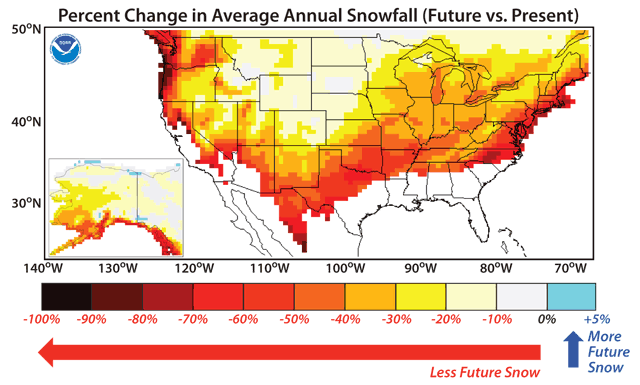February 15th, 2013
Key Findings
- GFDL’s new high-resolution global climate model, CM2.5, better represents snowfall and snow-related variables than CM2.1 in the present climate
- CM2.5 captures key spatial variability in snowfall, snowpack, and snow covered area when compared to observational estimates
- In the future climate, CM2.5 and CM2.1 agree globally with previous global model comparisons of global snowfall, with increases in snowfall in the high latitudes and decreases in the mid to low latitudes
- CM2.5 is unique in that its high resolution allows it to resolve complex orography, leading to a change in sign in snowfall projections over high mountains, in particular over the northwestern Himalayas, the highest peak in Southwest Yukon, and a location in the highest peaks in the Andes.
- A simple multiple regression model is used to show how precipitation and temperature influence snowfall trends; gains occur where the increasing precipitation signal overwhelms the temperature signal
Sarah Kapnick and Tom Delworth. Journal: Journal of Climate. DOI: 10.1175/JCLI-D-12-00528.1
Summary
Understanding snowfall variability is key to understanding future water supply in snowmelt-dominated regions, like the western U.S. This research validated GFDL’s coupled climate models, CM2.5 and CM2.1, for snowfall and explored changes in snowfall in a future climate experiment, to determine if resolution differences in the models influence snowfall signals.
The new high-resolution global climate model, CM2.5, better represents snowfall and snow-related variables than CM2.1 in the present climate. CM2.5 is unique in that its high resolution allows it to resolve complex orography, leading to a change in sign in snowfall projections over high mountains, in particular over the northwestern Himalayas, the highest peak in Southwest Yukon, and the highest peaks in the Andes. In the first two locations, literature supports such trends in the present climate, implying that they are a continuation. This work furthers the development for CM2.5 by validating the model and showing its ability to capture hydroclimate variability.
Over the U.S., the future climate experiment exhibits significant reductions in average annual snowfall. Figure 1 shows the geographic distribution of snowfall change in response to CO2 doubling as a percent of the control simulation. The only regions in the U.S. with snowfall gains are found in Alaska. The vast majority of the U.S. experiences snowfall loss, with the greatest percentages occurring in the south, along the eastern coast, and the Pacific Northwest. The continental interior experiences fewer reductions in snowfall. While this study focuses on mean annual snow variables, future work will focus on exploring changes in extreme snowfall events, such as the frequency of snow storms, and changes in seasonality.
Two GFDL models are used, CM2.1 (200km atmospheric resolution) and CM2.5 (50km atmospheric resolution), to run two simulations. In one simulation, greenhouse gases and aerosols were kept constant at 1990 levels for 240 years; the other was an idealized climate change experiment where carbon dioxide is increased by 1% a year until year 70, and then kept constant for an additional 70 years. Annual means of various climate variables were analyzed in the present climate and future climate. A multiple regression model was used to decompose the trends in snowfall into components of precipitation and temperature, to determine what drives snowfall changes.



